Linda’s Fantastic South American Adventure Concludes: Wet, Wild and Wonderful – Patagonia
By Linda Ballou, NABBW’s Adventure Travel Associate
NOTE: My sojourn in South America began and ended in Buenos Aires where half the population of Argentina reside. Like most Americans, my knowledge of the geography of South America is a bit fuzzy. The journey took me to less-traveled parts of Argentina and Chile providing an overview of the landscape and high points, which I have shared in a series of pieces. This is the third and final article in the series:
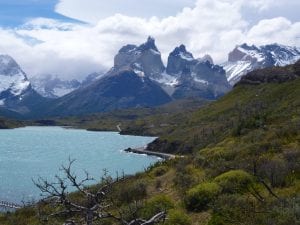 I am sipping coffee at Hotel Lago Grey in Torres del Paine, Chile before everyone arrives for breakfast. An exquisite rainbow is arcing to the left of a panorama of turquoise glacier-fed waters framed in snow tipped-giants that soar to 10,000 feet. I feel as misty as the gauzy clouds drifting over the Paine Massif; privileged to behold the grandeur before me.
I am sipping coffee at Hotel Lago Grey in Torres del Paine, Chile before everyone arrives for breakfast. An exquisite rainbow is arcing to the left of a panorama of turquoise glacier-fed waters framed in snow tipped-giants that soar to 10,000 feet. I feel as misty as the gauzy clouds drifting over the Paine Massif; privileged to behold the grandeur before me.
The five-hour drive across the undulating plains of Patagonia Steppe from Punta Arenas to Torres del Paine (Torres del Paine is Spanish for “Towers of Paine,” with “paine” being the old indigenous name for the colour blue) offered many wildlife sightings. The lesser rhea, a bird in the ostrich family, the favorite food of the Tehuelche Indians, was our first encounter.
The Southern-Crested Caracara, an opportunist by nature who stays close to the roadside hoping for easy pickings, became a common sighting. A highlight was watching an awkward take off by a grounded condor flapping his 9-foot wing span. We spotted a lone gaucho trotting briskly across the tawny waves of billowing grasses. They are as rare as a puma sighting since the sheep industry gave way to tourism in the region.
We passed Puerto Nogales where our local guide, Kris, lives in a house with no electricity or running water. She carts in water and has a generator and wood-burning stove for heat. Her life is rugged and hard, but she says she finds freedom in her walks in the mountains. She feels safe there. No snakes, no mosquitos, no altitude sickness, nothing that could harm a human save the elements that she knows how to read and is prepared for. She leads trekkers from around the globe who come to explore the magical vales on 5 and 10-day circuits in the park.
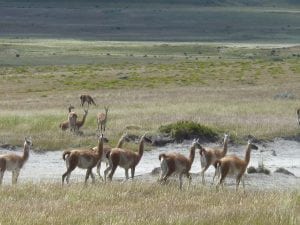
I fell in step behind Kris as we leaned into the wind on our first hike. It was into a lonely valley with a clear view of the salmon-colored towers of the Torres del Paine that pulled me to the ends of the earth an 8-hour hike away.
This Guanaco trail was lined with humps of a prickly bush only the guanaco can eat with their sticky tongues. Guanaco, distant relatives of the llama with doe eyes and gentle demeanor, will spit a vile green slime on you if you get too close They provided the Tehuelche with fur for their capes, foot coverings, and tents along with meat that they ate raw.
At Hotel Lago Grey, lodging inside the park, travelers congregate in the lounge with its warm ambiance and walls of glass overlooking Lago Grey. Once bedded down, I listened to a rowdy wind tossing the tree canopy and rain pelting my window. I slept like a squirrel with his tail tucked over his head and woke to the sun streaming through mist rising on the emerald green grass.
Mood swings in the weather are the norm. Layered clothing is the order of the day with rain pants in your daypack for good measure. We determined to stroll through the forest on the shore of Lago Grey to a swinging bridge across an energetic river to a view of the snout of the Grey Glacier. The path is lined with shrubs with tiny red berries locals turn into jam. There are yellow orchid, sweet peas, and fungi in the mossy undergrowth. The beech tree, or linga draped with old man’s beard, and the monkey puzzle are the most common trees. A solo stroll in the sheltered forest back to the lodge listening to birdsong made me very happy in that moment.
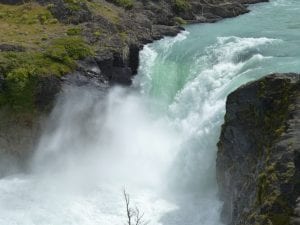 Furious winds lifting the waters to a cooling spray greeted us at Salto Grande, a turgid, turquoise waterfall charging from Lago Nordenskjöld into Lago Pehoé.
Furious winds lifting the waters to a cooling spray greeted us at Salto Grande, a turgid, turquoise waterfall charging from Lago Nordenskjöld into Lago Pehoé.
On our afternoon hike to the base of the famous Cuernos del Paine, AKA the Horns, Kris taught us to spot water mists dancing on the metallic lake. They tell you that a blast of air strong enough to knock a man off his feet is on the way. You learn to look for a protected area behind green mounds, and if you can’t find it you turn your back to the wind and place one foot in front of you and take a stand.
The winds have blasted bowls of granite in the imposing mountain and carved shafts into sharp fingers piercing blue skies. Ominous lenticular clouds crowding overhead fanned across the heavens. They can turn mean in moments and let loose a downpour that may pass as fast as it comes, but we were graced with a crystalline day.
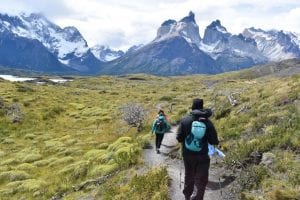 As I look out over Lago Grey, stippled with white caps, see the leaves whipping wildly in the ceaseless wind, I feel lucky to be here and to experience some of the Creator’s most magnificent handiwork. It is the grandeur and the awful power of the craggy giants reaching for the heavens guarding Lago Grey that remind me that wet and wild places are worth saving.
As I look out over Lago Grey, stippled with white caps, see the leaves whipping wildly in the ceaseless wind, I feel lucky to be here and to experience some of the Creator’s most magnificent handiwork. It is the grandeur and the awful power of the craggy giants reaching for the heavens guarding Lago Grey that remind me that wet and wild places are worth saving.
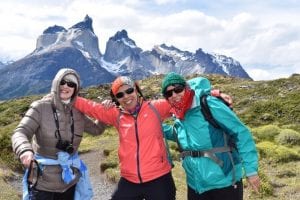 Thank you to Overseas Adventure Travel for this exciting 17 day sojourn into South America from the Andes to Patagonia that climaxed with a visit to Torres del Paine National Park.
Thank you to Overseas Adventure Travel for this exciting 17 day sojourn into South America from the Andes to Patagonia that climaxed with a visit to Torres del Paine National Park.
Note: the group picture at left and the shot above of our group traveling single file are courtesy of Susan Pendrick. All other images by Linda Ballou.
For a complete bio as well as published on-line clips with photos go to my website www.LindaBallouAuthor.com. Your reward, aside from learning about me and my work, will be to discover the secret to youth! Follow my blog or friend me on Facebook to keep up with my latest adventures.
If You Go:
Here are several useful links:

 Linda's mission is to experience as many beautiful places on our planet as she can before they are no more. Travel tales relating her experiences while kayaking, horseback riding, sailing, birding and hiking about the globe have appeared in numerous national magazines. She had great fun collecting travel stories, and profiles of people she met in “naturally high places” for her book, Lost Angel Walkabout-One Traveler’s Tales. Her latest book Lost Angel Unleashed is the third book in her Lost Angel Trilogy
Linda's mission is to experience as many beautiful places on our planet as she can before they are no more. Travel tales relating her experiences while kayaking, horseback riding, sailing, birding and hiking about the globe have appeared in numerous national magazines. She had great fun collecting travel stories, and profiles of people she met in “naturally high places” for her book, Lost Angel Walkabout-One Traveler’s Tales. Her latest book Lost Angel Unleashed is the third book in her Lost Angel Trilogy

Leave a Reply
You must be logged in to post a comment.